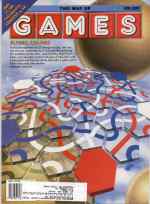KALIKO
This boardless path-connecting game is an improved version of Psyche-Paths, a little-known but highly original game of the 1960s. The rules have been streamlined, some solitaire puzzles have been added, and the silk-screened Lucite tiles give the game a striking appearance that does justice to the sophistication of the play.
Two to four players draw seven tiles apiece from a bag, and keep them hidden from the opponents behind bamboo screens. One more tile is drawn and placed on a flat surface of at least card-table size. Each tile—there are 85 of them, all different—depicts three path segments in varying configurations and color combinations. In turn, each player adds one or more tiles from his hand to those already on the table, matching like-colored path segments wherever tiles meet. The tiles played in a turn must connect two previously unconnected path segments. The longer a connected path is, the more points it's worth; as the game progresses and paths grow longer, plays tend to score more and more points. Bonuses are earned for making a path cross itself and for turning a path into a closed loop.
Finding a reasonably good move is seldom hard; finding the very best move is seldom easy. Luck is important, but so are a strong sense of spatial relations and the ability to plan strategically. The outcome is often in doubt until the very end, and it's highly satisfying to find a play that simultaneously connects two or more sets of paths, scoring enough points to come from far behind and win. — R.W.S.







